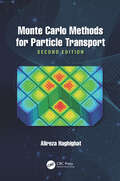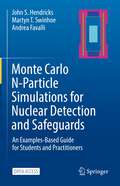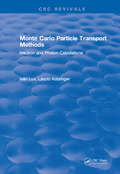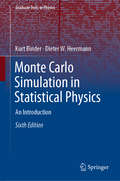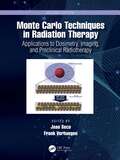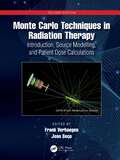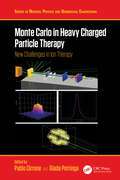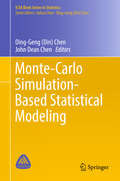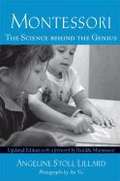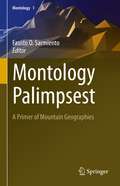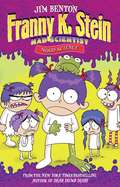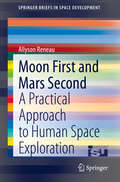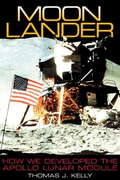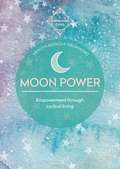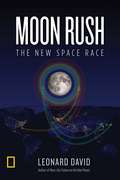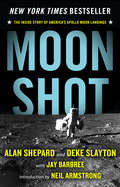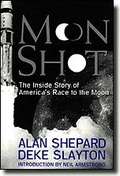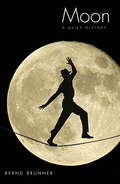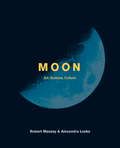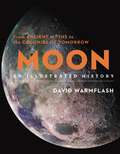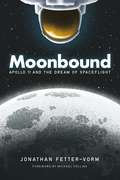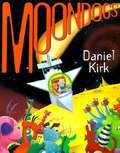- Table View
- List View
Monte Carlo Methods for Particle Transport
by Alireza HaghighatFully updated with the latest developments in the eigenvalue Monte Carlo calculations and automatic variance reduction techniques and containing an entirely new chapter on fission matrix and alternative hybrid techniques. This second edition explores the uses of the Monte Carlo method for real-world applications, explaining its concepts and limitations. Featuring illustrative examples, mathematical derivations, computer algorithms, and homework problems, it is an ideal textbook and practical guide for nuclear engineers and scientists looking into the applications of the Monte Carlo method, in addition to students in physics and engineering, and those engaged in the advancement of the Monte Carlo methods. Describes general and particle-transport-specific automated variance reduction techniques Presents Monte Carlo particle transport eigenvalue issues and methodologies to address these issues Presents detailed derivation of existing and advanced formulations and algorithms with real-world examples from the author’s research activities
Monte Carlo N-Particle Simulations for Nuclear Detection and Safeguards: An Examples-Based Guide for Students and Practitioners
by John S. Hendricks Martyn T. Swinhoe Andrea FavalliThis open access book is a pedagogical, examples-based guide to using the Monte Carlo N-Particle (MCNP®) code for nuclear safeguards and non-proliferation applications. The MCNP code, general-purpose software for particle transport simulations, is widely used in the field of nuclear safeguards and non-proliferation for numerous applications including detector design and calibration, and the study of scenarios such as measurement of fresh and spent fuel. This book fills a gap in the existing MCNP software literature by teaching MCNP software usage through detailed examples that were selected based on both student feedback and the real-world experience of the nuclear safeguards group at Los Alamos National Laboratory. MCNP input and output files are explained, and the technical details used in MCNP input file preparation are linked to the MCNP code manual. Benefiting from the authors’ decades of experience in MCNP simulation, this book is essential reading for students, academic researchers, and practitioners whose work in nuclear physics or nuclear engineering is related to non-proliferation or nuclear safeguards. Each chapter comes with downloadable input files for the user to easily reproduce the examples in the text.
Monte Carlo Particle Transport Methods
by I. LuxWith this book we try to reach several more-or-less unattainable goals namely: To compromise in a single book all the most important achievements of Monte Carlo calculations for solving neutron and photon transport problems. To present a book which discusses the same topics in the three levels known from the literature and gives us useful information for both beginners and experienced readers. It lists both well-established old techniques and also newest findings.
Monte Carlo Simulation in Statistical Physics: An Introduction (Graduate Texts in Physics #Vol. 80)
by Kurt Binder Dieter W. HeermannThe sixth edition of this highly successful textbook provides a detailed introduction to Monte Carlo simulation in statistical physics, which deals with the computer simulation of many-body systems in condensed matter physics and related fields of physics and beyond (traffic flows, stock market fluctuations, etc.). Using random numbers generated by a computer, these powerful simulation methods calculate probability distributions, making it possible to estimate the thermodynamic properties of various systems. The book describes the theoretical background of these methods, enabling newcomers to perform such simulations and to analyse their results. It features a modular structure, with two chapters providing a basic pedagogic introduction plus exercises suitable for university courses; the remaining chapters cover major recent developments in the field.This edition has been updated with two new chapters dealing with recently developed powerful special algorithms and with finite size scaling tools for the study of interfacial phenomena, which are important for nanoscience. Previous editions have been highly praised and widely used by both students and advanced researchers.
Monte Carlo Techniques in Radiation Therapy: Applications to Dosimetry, Imaging, and Preclinical Radiotherapy (Imaging in Medical Diagnosis and Therapy)
by Joao SecoThoroughly updated throughout, this second edition of Monte Carlo Techniques in Radiation Therapy: Applications to Dosimetry, Imaging, and Preclinical Radiotherapy, edited by Joao Seco and Frank Verhaegen, explores the use of Monte Carlo methods for modelling various features of internal and external radiation sources. Monte Carlo methods have been heavily used in the field of radiation therapy in applications such as dosimetry, imaging, radiation chemistry, modelling of small animal irradiation units, etc. The aim of this book is to provide a compendium of the Monte Carlo methods that are commonly used in radiation therapy applications, which will allow students, postdoctoral fellows, and university professors to learn and teach Monte Carlo techniques. This book provides concise but detailed information about many Monte Carlo applications that cannot be found in any other didactic or scientific book. This second edition contains many new chapters on topics such as: Monte Carlo studies of prompt gamma emission Developments in proton imaging Monte Carlo for cone beam CT imaging Monte Carlo modelling of proton beams for small animal irradiation Monte Carlo studies of microbeam radiation therapy Monte Carlo in micro- and nano-dosimetry GPU-based fast Monte Carlo simulations for radiotherapy This book is primarily aimed at students and scientists wishing to learn and improve their knowledge of Monte Carlo methods in radiation therapy.
Monte Carlo Techniques in Radiation Therapy: Introduction, Source Modelling, and Patient Dose Calculations (Imaging in Medical Diagnosis and Therapy)
by Frank VerhaegenAbout ten years after the first edition comes this second edition of Monte Carlo Techniques in Radiation Therapy: Introduction, Source Modelling, and Patient Dose Calculations, thoroughly updated and extended with the latest topics, edited by Frank Verhaegen and Joao Seco. This book aims to provide a brief introduction to the history and basics of Monte Carlo simulation, but again has a strong focus on applications in radiotherapy. Since the first edition, Monte Carlo simulation has found many new applications, which are included in detail. The applications sections in this book cover the following: Modelling transport of photons, electrons, protons, and ions Modelling radiation sources for external beam radiotherapy Modelling radiation sources for brachytherapy Design of radiation sources Modelling dynamic beam delivery Patient dose calculations in external beam radiotherapy Patient dose calculations in brachytherapy Use of artificial intelligence in Monte Carlo simulations This book is intended for both students and professionals, both novice and experienced, in medical radiotherapy physics. It combines overviews of development, methods, and references to facilitate Monte Carlo studies.
Monte Carlo in Heavy Charged Particle Therapy: New Challenges in Ion Therapy (Series in Medical Physics and Biomedical Engineering)
by Pablo Cirrone Giada PetringaThis book explores the current difficulties and unsolved problems in the field of particle therapy and, after analysing them, discusses how (and if) innovative Monte Carlo approaches can be used to solve them. Each book chapter is dedicated to a different sub-discipline, including multi-ion treatments, flash-radiotherapy, laser-accelerated beams, nanoparticles effects, binary reactions to enhance radiobiology, and space-related issues. This is the first book able to provide a comprehensive insight into this exciting field and the growing use of Monte Carlo in medical physics. It will be of interest to graduate students in medicine and medical physics, in addition to researchers and clinical staff. Key Features: Explores the exciting and interdisciplinary topic of Monte Carlo in particle therapy and medicine. Addresses common challenges in the field. Edited by an authority on the subject, with chapter contributions from specialists. Pablo Cirrone is a medical physicist and researcher at the Laboratori Nazionali del Sud of INFN, Italy, where he supports and coordinates various experimental groups. Dr. Cirrone is an expert in the use of proton and ion in radiation treatment and of absolute and relative dosimetry in electron, photon and ion beam. He is an expert in the development and test of detectors for medical applications, of the production and use of laser-driven beams for medical and multidisciplinary applications and recipient of the Michael Gotein Award. He is active on many scientific committees and organizes national and international conferences. Giada Petringa is a researcher at the Laboratori Nazionali del Sud of INFN, Italy. Dr. Petringa has a professional experience in the field of Monte Carlo simulations for medical applications, dosimetry, microdosimetry, and diagnostics with conventional and laser-driven proton beams. In 2019 she had a MSCA-IF-2019 (Marie Sklodowska-Curie Actions-Individual Fellowship) grant funded by the European Community in the framework of the H2020 program. She is a member of the Editorial Board of the international journal Physica Medica - European Journal of Medical. She organized more than fifteen international Geant4 Schools. She is an official member of the Geant4 code Collaboration at CERN since 2019. She is a code developer, and she collaborates to maintain two of the official examples of the code.
Monte-Carlo Simulation-Based Statistical Modeling
by Ding-Geng Din Chen John Dean ChenThis book brings together expert researchers engaged in Monte-Carlo simulation-based statistical modeling, offering them a forum to present and discuss recent issues in methodological development as well as public health applications. It is divided into three parts, with the first providing an overview of Monte-Carlo techniques, the second focusing on missing data Monte-Carlo methods, and the third addressing Bayesian and general statistical modeling using Monte-Carlo simulations. The data and computer programs used here will also be made publicly available, allowing readers to replicate the model development and data analysis presented in each chapter, and to readily apply them in their own research. Featuring highly topical content, the book has the potential to impact model development and data analyses across a wide spectrum of fields, and to spark further research in this direction.
Montessori: The Science Behind The Genius (Updated Edition)
by Angeline Stoll LillardOne hundred years ago, Maria Montessori, the first female physician in Italy, devised a very different method of educating children, based on her observations of how they naturally learn. In Montessori, Angeline Stoll Lillard shows that science has finally caught up with Maria Montessori. Lillard presents the research behind eight insights that are foundations of Montessori education, describing how each of these insights is applied in the Montessori classroom. In reading this book, parents and teachers alike will develop a clear understanding of what happens in a Montessori classroom and, more important, why it happens and why it works. Lillard, however, does much more than explain the scientific basis for Montessori's system: Amid the clamor for evidence-based education, she presents the studies that show how children learn best, makes clear why many traditional practices come up short, and describes an ingenious alternative that works. Now with a foreword by Renilde Montessori, the youngest grandchild of Maria Montessori, Montessori offers a wealth of insights for anyone interested in education.
Montology Palimpsest: A Primer of Mountain Geographies (Montology #1)
by Fausto O. SarmientoThis book introduces an innovative approach to sustainable and regenerative mountain development. Transdisciplinary to biophysical and biocultural scales, it provides answers to the "what, when, how, why, and where" that researchers question on mountains, including the most challenging: So What! Forwarding thinking in its treatment of core subjects, this decolonial, non-hegemonic volume inaugurates the Series with contributions of seasoned montologists, and invites the reader to an engaging excursion to ascend the rugged topography of paradigms, with the scaffolding hike of ambitious curiosity typical of mountain explorers.Chapter 8 is available open access under a Creative Commons Attribution 4.0 International License via link.springer.com.
Mood Science (Franny K. Stein, Mad Scientist #10)
by Jim BentonFans of Goosebumps and Bill Nye the Science Guy will fall head over heels for Franny K. Stein, who is back with another laugh-out-loud experimental adventure in the tenth book in the Mad Scientist series.Franny K. Stein has had quite enough of her feelings getting in the way. So she physically removes them with the help of one of her machines. But it turns out that not having feelings can make things even worse, especially when you&’ve accidentally released a virus that&’s turning everybody into toads. Good thing she has the help of her grandma, Granny Fran, and her Sense of Duty to help her shake the apathy.
Moon Camp
by Barry GottWhat if summer camp was in outer space?Summer is here! But Jake doesn't want to go to summer camp. Even if camp is on the moon. Sure enough, he gets lost during the nature hike, his air canoe springs a leak, there's scary noises at night, and he's pretty sure he's allergic to moon dust. The worst part? He misses home. But then Sam arrives and maybe Moon Camp isn't so bad after all? Full of out-of-this-world humor, Moon Camp is a celebration of new adventures and the unexpected friends you make along the way.
Moon First and Mars Second: A Practical Approach to Human Space Exploration (SpringerBriefs in Space Development)
by Allyson ReneauThis SpringerBrief explores the technological, economic, physiological, and psychological comparisons between a journey to the Moon versus a journey to Mars, taking into consideration the national and international perspectives at play. The author spent over six years interviewing leading space experts from around the world to learn why lunar habitats and the creation of a permanent presence on the Moon are an essential next step to human exploration and settlement in space. Practical reasons related to energy, telecommunications and networking, robotic systems, medical and scientific research, material processing, and more show why it must be the Moon First and Mars Second. These findings and recommendations have been adopted by current NASA Administrator Jim Bridenstine, as well as the current U. S. president. The research in this text reflects the author's experiences working internally within NASA Headquarters, the FAA Commercial Spaceflight Office, as well as the International Space University. It is partially based on Reneau’s award-winning Harvard thesis in conjunction with her Master's in International Relations.
Moon Lander
by Thomas J. KellyChief engineer Thomas J. Kelly gives a firsthand account of designing, building, testing, and flying the Apollo lunar module. It was, he writes, "an aerospace engineer's dream job of the century." Kelly's account begins with the imaginative process of sketching solutions to a host of technical challenges with an emphasis on safety, reliability, and maintainability. He catalogs numerous test failures, including propulsion-system leaks, ascent-engine instability, stress corrosion of the aluminum alloy parts, and battery problems, as well as their fixes under the ever-present constraints of budget and schedule. He also recaptures the exhilaration of hearing Apollo 11's Neil Armstrong report that "The Eagle has landed," and the pride of having inadvertently provided a vital "lifeboat" for the crew of the disabled Apollo 13.From the Hardcover edition.
Moon Power: Empowerment through cyclical living
by Merilyn KeskulaThe Moon is not just a static piece of cosmic matter in our night sky, but a dynamic living being. Throughout her journey around the Earth which takes about 29.5 days she shows us her different faces, growing from a silver sliver in the sky to an awe-inspiring illuminated sphere, before returning to darkness again. She changes colour and moves through a variety of star constellations reflecting the energies at play each day. The Moon gives us a map to a cyclical way of living; the blueprint for a life that breathes in harmony with the rhythm of the natural world around us. She teaches us about the importance of embracing quiet and reflective times as much as celebrating the times we experience life in its fullest expression. She informs us when to plant the seeds of our dreams and when to take stock and harvest what we have been growing. What will you discover about yourself when you tune into the moon?
Moon Power: Empowerment through cyclical living
by Merilyn KeskulaThe Moon is not just a static piece of cosmic matter in our night sky, but a dynamic living being. Throughout her journey around the Earth which takes about 29.5 days she shows us her different faces, growing from a silver sliver in the sky to an awe-inspiring illuminated sphere, before returning to darkness again. She changes colour and moves through a variety of star constellations reflecting the energies at play each day. The Moon gives us a map to a cyclical way of living; the blueprint for a life that breathes in harmony with the rhythm of the natural world around us. She teaches us about the importance of embracing quiet and reflective times as much as celebrating the times we experience life in its fullest expression. She informs us when to plant the seeds of our dreams and when to take stock and harvest what we have been growing. What will you discover about yourself when you tune into the moon?
Moon Rush: The New Space Race
by Leonard DavidVeteran space journalist digs into the science and technology--past, present, and future--central to our explorations of Earth's only satellite, the space destination most hotly pursued today.In these rich pages, veteran science journalist Leonard David explores the moon in all its facets, from ancient myth to future "Moon Village" plans. Illustrating his text with maps, graphics, and photographs, David offers inside information about how the United States, allies and competitors, as well as key private corporations like Moon Express and Jeff Bezos's Blue Origin, plan to reach, inhabit, and even harvest the moon in the decades to come.Spurred on by the Google Lunar XPRIZE--$20 million for the first to get to the moon and send images home--the 21st-century space race back to the moon has become more urgent, and more timely, than ever. Accounts of these new strategies are set against past efforts, including stories never before told about the Apollo missions and Cold War plans for military surveillance and missile launches from the moon. Timely and fascinating, this book sheds new light on our constant lunar companion, offering reasons to gaze up and see it in a different way than ever before.
Moon Shot: The Inside Story of America's Apollo Moon Landings
by Jay Barbree Deke Slayton Alan ShepardNew York Times bestseller for fans of First Man: A &“breathtaking&” insider history of NASA&’s space program—from astronauts Alan Shepard and Deke Slayton (Entertainment Weekly). On October 4, 1957, the Soviet Union launched Sputnik I, and the space race was born. Desperate to beat the Russians into space, NASA put together a crew of the nation&’s most daring test pilots: the seven men who were to lead America to the moon. The first into space was Alan Shepard; the last was Deke Slayton, whose irregular heartbeat kept him grounded until 1975. They spent the 1960s at the forefront of NASA&’s effort to conquer space, and Moon Shot is their inside account of what many call the twentieth century&’s greatest feat—landing humans on another world. Collaborating with NBC&’s veteran space reporter Jay Barbree, Shepard and Slayton narrate in gripping detail the story of America&’s space exploration from the time of Shepard&’s first flight until he and eleven others had walked on the moon.
Moon Shot: The Inside Story of America's Race to the Moon
by Deke Slayton Neil Armstrong Alan Shepard'Houston, Tranquility Base here. The Eagle has landed." This terse message transmitted live from the surface of the Moon twenty-five years ago, on July 20, 1969, was heard by more than a billion people a quarter of a million miles away on Earth. It was a once in-a-lifetime moment when all humankind was united in awe and triumph, and nowhere was the exultation greater than at Mission Control, where Alan Shepard and Deke Slayton were among the wildly cheering NASA personnel. Both men were heroes of the New Frontier, members of one of the world's smallest elites: the Mercury Seven, America's original astronauts. Shepard was our first man in space; Slayton would fly on one of the last Apollo missions, the historic rendezvous, with the Soviet spacecraft Soyuz, which signaled a brief pause in the intense race between the US and the USSR to establish preeminence in space. Alan Shepard and Deke Slayton were part of America's effort to reach the Moon from the very beginning, and no one else could be as qualified to tell this fascinating and thrilling tale of the courage, dedication, and teamwork that made the journey to the moon possible. MOON SHOT is a compelling human drama of the sacrifices and risks asked of a small but remarkable group of astronauts who put their lives on the line as they led the way to the lunar landscape a quarter of a century ago. It's the story of those who built, launched, and flew America's spacecraft, a dramatic account of a decade of superpower rivalry, scientific discovery, and personal bravery.
Moon! Earth's Best Friend (Our Universe #3)
by Stacy McAnultyFrom writer Stacy McAnulty and illustrator Stevie Lewis, Moon! Earth's Best Friend is a light-hearted nonfiction picture book about the formation and history of the moon—told from the perspective of the moon itself.Meet Moon! She's more than just a rock—she’s Earth’s rock, her best friend she can always count on. Moon never turns her back on her friend (literally: she's always facing Earth with the same side!). These two will stick together forever. With characteristic humor and charm, Stacy McAnulty channels the voice of Moon in this next celestial "autobiography" in the Our Universe series. Rich with kid-friendly facts and beautifully brought to life by Stevie Lewis, this is an equally charming and irresistible companion to Earth! My First 4.54 Billion Years and Sun! One in a Billion.
Moon: A Brief History
by Bernd BrunnerWerewolves and Wernher von Braun, Stonehenge and the sex lives of sea corals, aboriginal myths, and an Anglican bishop: In his new book, Moon, Bernd Brunner weaves variegated information into an enchanting glimpse of Earth's closest celestial neighbor, whose mere presence inspires us to wonder what might be "out there." Going beyond the discoveries of contemporary science, Brunner presents an unusual cultural assessment of our complex relationship with Earth's lifeless, rocky satellite. As well as offering an engaging perspective on such age-old questions as "What would Earth be like without the moon?" Brunner surveys the moon's mythical and religious significance and provokes existential soul-searching through a lunar lens, inquiring, "Forty years ago, the first man put his footprint on the moon. Will we continue to use it as the screen onto which we cast our hopes and fears?" Drawing on materials from different cultures and epochs, Brunner walks readers down a moonlit path illuminated by more than seventy-five vintage photographs and illustrations. From scientific discussions of the moon's origins and its "chronobiological" effects on the mating and feeding habits of animals to an illuminating interpretation of Bishop Francis Godwin's 1638 novelThe Man in the Moone, Brunner's ingenious and interdisciplinary explorations recast a familiar object in an entirely original and unforgettable light and will change the way we view the nighttime sky.
Moon: Art, Science, Culture
by Robert Massey Alexandra LoskeA source of light in the dark of night and our ever-changing cosmic companion, the Moon has fascinated humankind since we first gazed into the sky. In this extensively illustrated and illuminating volume, art historian Alexandra Loske and astronomer Robert Massey present a rich and curious history. From its violent birth through to the exhilarating story of the Space Race and current exploration efforts, discover the many faces of the Moon and how they have shaped humanity's existence.
Moon: From Ancient Myths to the Colonies of Tomorrow (Union Square & Co. Illustrated Histories)
by David WarmflashFrom the moon&’s formation, to its potential for future exploration, this richly illustrated volume presents 100 milestones in lunar history. With dazzling images on every spread, and illuminating text by astrobiologist Dr. David Warmflash, Moon: An Illustrated History chronologically presents 100 milestones in the Moon&’s development and exploration. Starting 4.5 billion years ago when the Moon formed, this stunning volume moves from the hypotheses of the Moon&’s formation (4.5 billion years ago) to sixth-century BCE predictions of solar eclipses, from the twentieth-century Space Race between the US and the Soviet Union to private space companies and possible future lunar colonies. Find out about lunar calendar systems and cults in the Bible; how lunar brightness was used to estimate stellar distances; how advancing telescopes in the seventeenth century allowed us to eye the Moon more closely; how author Jules Verne inspired the Father of Astronautics; the originals of the Saturn V Moon Rocket; the Apollo missions, and so much more.
Moonbound: Apollo 11 and the Dream of Spaceflight
by Jonathan Fetter-VormOn a summer night in 1969, two men climbed down a ladder onto a sea of dust at the edge of an ancient dream. When Neil Armstrong and Buzz Aldrin first set foot on lunar soil, the moon ceased to be a place of mystery and myth. It became a destination.Now, on the fiftieth anniversary of that journey, Moonbound tells the monumental story of the moon and the men who went there first. With vibrant images and meticulous attention to detail, Jonathan Fetter-Vorm conjures the long history of the visionaries, stargazers, builders, and adventurers who sent Apollo 11 on its legendary voyage.From the wisdom of the Babylonians to the intrigues of the Cold War, from the otherworldly discoveries of Galileo to the dark legacy of Nazi atrocities, from the exhilarating trajectories of astronauts—recounted in their own words—to the unsung brilliance of engineers working behind the scenes, Moonbound captures the grand arc of the Space Age in a graphic history of unprecedented scope and profound lyricism.
Moondogs
by Daniel KirkThere are amazing-looking dogs on the moon! Young Willy knows because he has been watching them through his telescope. When his dad suggests he ought to have a pet, Willy builds a rocket just his size, and sets off on the adventure of a lifetime. Willy's heart is set on finding a dog like you've never seen before and readers will be surprised to see what he brings home!
